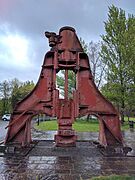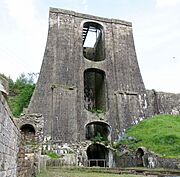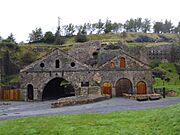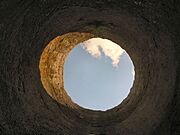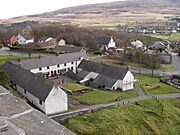Blaenavon Ironworks facts for kids
Quick facts for kids Blaenavon Ironworks |
|
|---|---|
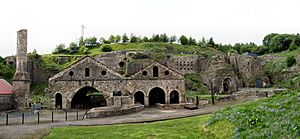 |
|
| Type | Ironworks |
| Location | Blaenavon, Torfaen, Wales |
| Owner | Cadw |
| Official name: Blaenavon Industrial Landscape | |
| Designated | 2000 |
|
Listed Building – Grade I
|
|
| Official name: Cast House and Foundry | |
| Designated | 9 February 1995 |
| Reference no. | 15296 |
|
Listed Building – Grade I
|
|
| Official name: Blast Furnances | |
| Designated | 9 February 1995 |
| Reference no. | 15294 |
|
Listed Building – Grade I
|
|
| Official name: Balance Tower | |
| Designated | 9 February 1995 |
| Reference no. | 15292 |
| Lua error in Module:Location_map at line 420: attempt to index field 'wikibase' (a nil value). | |
Blaenavon Ironworks is an old factory site in Blaenavon, Wales. Today, it is a museum where you can learn about its history. This ironworks was very important because it helped people learn how to use cheaper, lower-quality iron ores from all over the world.
It was also the place where Sidney Gilchrist Thomas and his cousin Percy Gilchrist did their experiments. These experiments led to a new way of making steel, called "the basic steel process" or "Gilchrist–Thomas process".
The ironworks is located near the town of Blaenavon, in an area called the Blaenavon Industrial Landscape. This whole area is a World Heritage Site, which means it's recognized as very important globally. Cadw, the Welsh Government's service for historic places, takes care of the site.
Contents
History of the Ironworks
Early Days of Iron Making
People have been working with iron in the South Wales Valleys since the time of the Romans. In the 1600s, the Hanbury family from Pontypool made tinplate in the Blaenavon area.
In 1788, three businessmen from the Midlands – Thomas Hill, Thomas Hopkins, and Benjamin Pratt – leased a large piece of land. This area was perfect for making iron because the three main things needed – coal, iron ore, and limestone – were all found close to the surface. This made them easy to dig up without needing deep mines.
Work on the ironworks started right away. They built cottages for the workers too. Blaenavon Ironworks was special because it was the first in Wales designed to have many furnaces from the very beginning. It had three furnaces, kilns for preparing materials, homes for workers, and a company shop.
A Visitor's View in 1799
A historian named William Coxe visited Blaenavon in 1798–99. He was very impressed, describing the town as a "rich and growing place" surrounded by piles of ore, coal, and limestone.
The ironworks needed skilled workers who would stay in the area. Before this, ironworks in places like Pontypool used charcoal and water power. Blaenavon was different because it used new coal-burning technology and steam power.
Skilled workers came from other parts of Wales, England, and Ireland. Many unskilled workers and their families also came, hoping to find jobs. The population of the area grew a lot, from just over 1,000 people in 1800 to 5,115 in 1840. Most people spoke Welsh, but some spoke English.
The 1800s: Growth and Challenges
By 1800, Blaenavon Ironworks helped make South Wales the world's top iron-producing region. Blaenavon was the second-largest iron producer in Wales, after Cyfarthfa Ironworks.
Over the next ten years, two more furnaces were added. In 1804, a forge (a place where metal is shaped) was built nearby in Cwmavon. By 1833, the company owned 430 houses and employed 1,000 workers. However, the iron industry often had "boom-and-bust" times, with good periods followed by bad ones. This led to wage cuts and strikes.
In 1836, the Blaenavon Iron and Coal Company bought the works. A London businessman named Robert Kennard provided the money. The new manager, James Ashwell, invested a lot of money to improve the ironworks. They built the amazing balance tower, which used water to lift heavy pig iron from the bottom of the site up to the Brecknock and Abergavenny Canal. This canal offered cheaper ways to transport goods to Newport.
Even with this big investment, the site didn't make much profit, and Ashwell had to leave in 1840. In the years that followed, iron rails made at Blaenavon were sent all over the world, including India, Russia, and Brazil. They were also used for projects closer to home, like building the Crumlin Viaduct.
After Ashwell left, Mr. Scrivener became the manager. Sales of iron went up for a while, reaching a peak in 1845. But by 1847, sales dropped again. The works continued to struggle. In 1849, less pig iron was made, partly because the furnaces were shut down for three months. It was also said that workers refused to accept lower wages, which the company felt was needed because of the tough times in the iron industry.
The company was restarted in 1870 as the Blaenavon Iron & Steel Company. It was one of only six ironworks in South Wales that successfully switched to making steel. By 1878, the company employed 5,000 people. However, it had spent too much money and couldn't compete with other companies.
Just when the company was about to fail, Sidney Gilchrist Thomas and Percy Carlyle Gilchrist made important discoveries. Their experiments, done at Blaenavon between 1877 and 1878, allowed companies to use phosphoric iron ore, which was previously too expensive to use. This helped Blaenavon for a short time. But it also meant that Germany and North America could now use their own phosphoric ores, which sped up the decline of Blaenavon Ironworks.
In 1880, the Blaenavon Company opened Big Pit coal mine and stopped making iron completely.
The 1900s and Today
In 1904, the ironworks stopped making anything. Work started again briefly in 1924, but it wasn't profitable. The forges at the site were still used to help make steel shells during both World Wars. For a long time, the site was mostly used as a storage yard for the National Coal Board.
In 1974, people started working to preserve the ironworks. Soon after, the ironworks and other sites in Blaenavon were given special legal protection. In 2001, the site had a big restoration project. Old cast iron parts of the tower were taken down, remade, and painted. Today, Cadw looks after the site.
Buildings and Features
Clive Aslet, an expert, says that Blaenavon is "the best-preserved industrial relic of its kind."
Coal House and Stack Square
Stack Square is a small group of cottages where workers used to live. These cottages have been restored to look like they did in the past. They are now part of the ironworks museum. Inside, they are furnished to show what life was like in different time periods, from the 1870s to the 1970s.
Special Heritage Status
UNESCO World Heritage Site
In 2000, the ironworks and the larger Blaenavon Industrial Landscape were named a UNESCO World Heritage Site. This recognized how important the site was to South Wales being the world's main producer of iron and coal in the 1800s.
Scheduled Monument
Blaenavon Ironworks is also a Scheduled monument, which means it's a nationally important archaeological site or historic building.
Listed Buildings
Many buildings at the site are "listed structures," meaning they are protected because of their special historical or architectural importance. Three of them have the highest protection, Grade I: the Cast House and Foundry, the Balance Tower, and the three Blast Furnaces. Other buildings, like the Chain Store, the Calcining Kilns, a Storage Shed, the Pay Office, and Stack Square, are listed at Grade II. There is also a memorial to the Gilchrist cousins.
Gallery
See also



